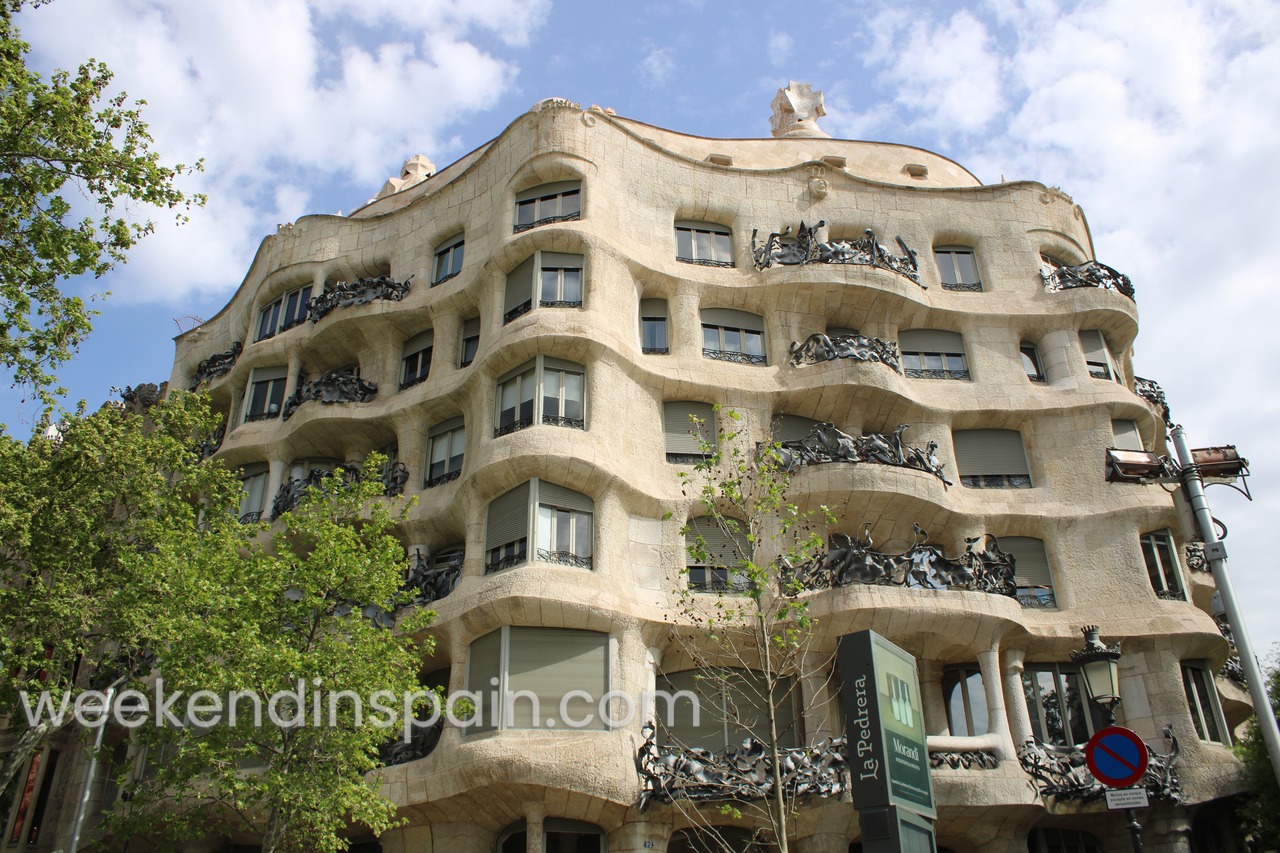
My second favourite monument in Barcelona, after La Sagrada Família, is La Pedrera. The man behind this awe-inspiring, monumental building is none other than Antoni Gaudi.
The history of La Casa Mila, La Pedrera dates back to the early 20th century, when all the rich members of the bourgeois family chose Passeig de Gràcia to build their homes by giving the task to the finest architects. Among them was none other than Antoni Gaudí, who was commissioned to build the infamous La Casa Mila, popularly known as La Pedrera.
Table of Contents
RECENT FACTS ABOUT LA PEDRERA
La Pedrera is well-known for its ornate and unique façade. It was declared a World Heritage Site in 1984 by UNESCO.
Since 2013, the monument has been under the care of the Catalunya La Pedrera Foundation, which organises lots of activities and also offers rooms for public use.
ARCHITECTURE OF LA PEDRERA
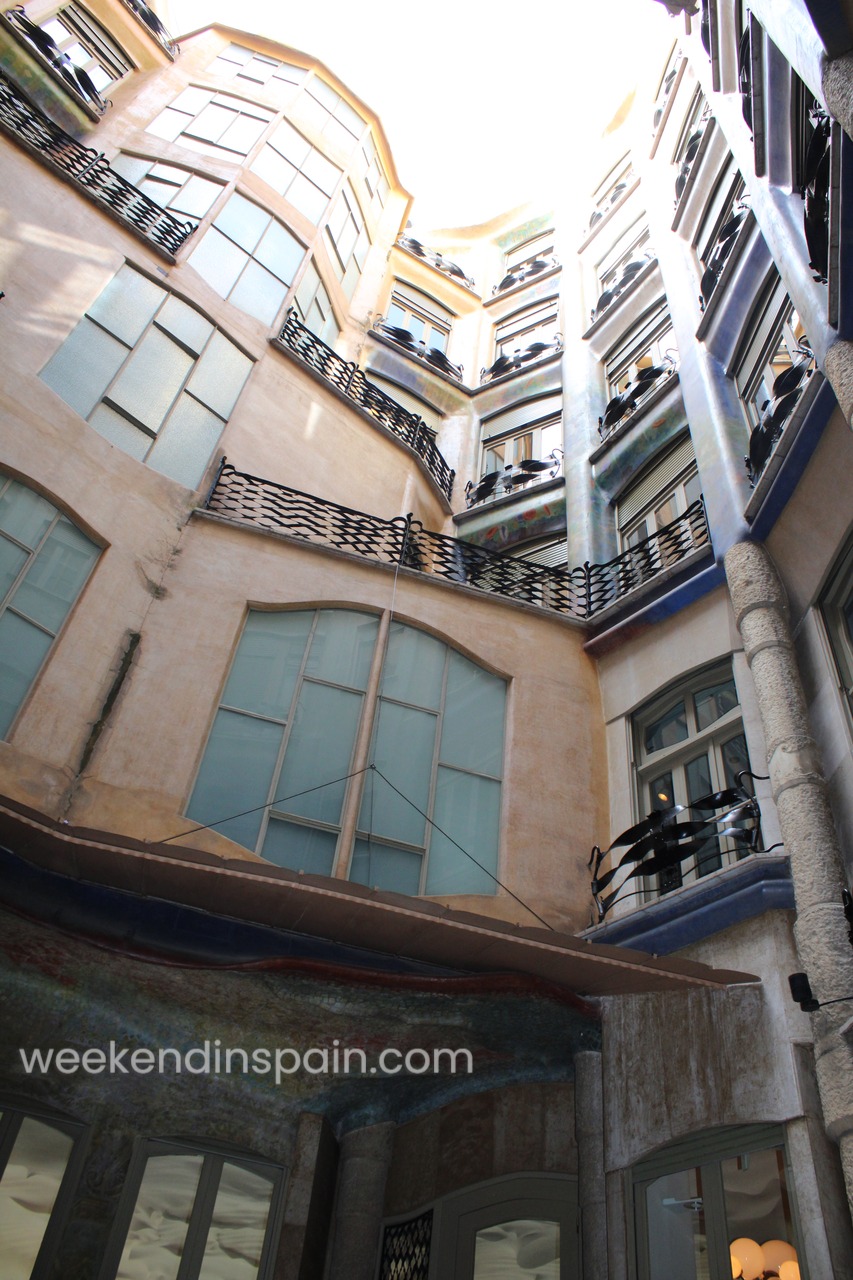
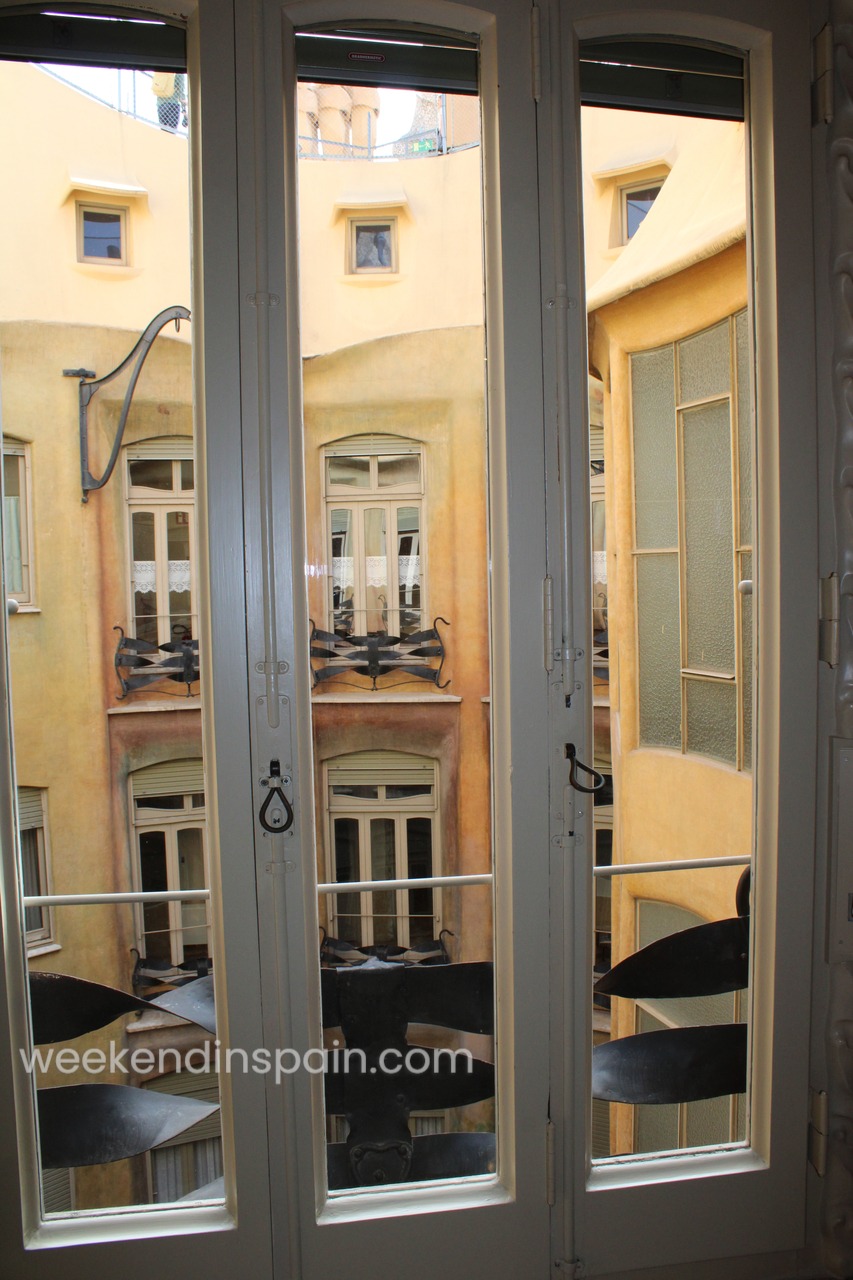
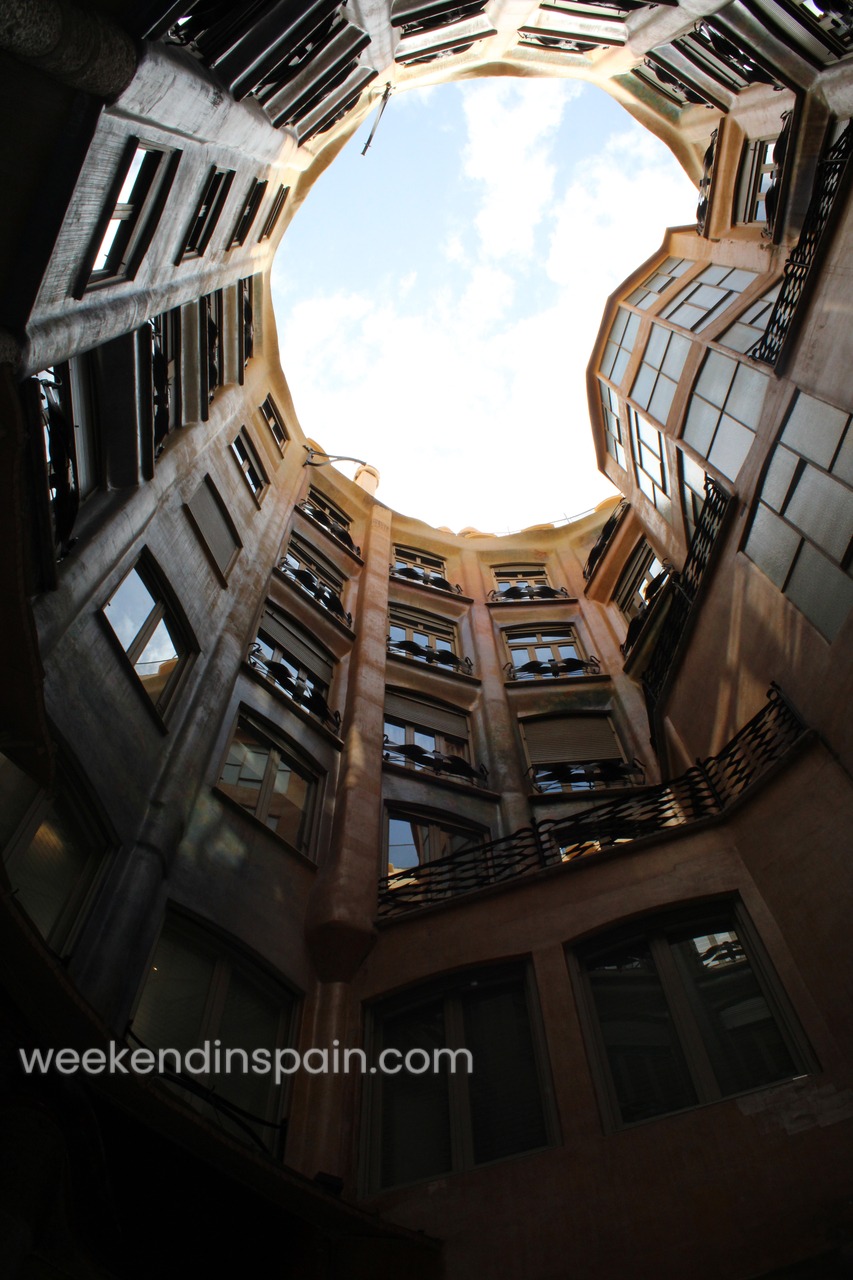
La Pedrera consists of two blocks of apartments with two beautiful interconnected courtyards that have access to the garage and provide natural light to all the floors of the building.
According to what I have seen, observed and read about Gaudí’s approach to architecture, he used all scrap and recycled materials, along with creating his projects based on nature. Also, natural light and ventilation were his top priorities, and for that he designed two large patios that provided natural light to all the floors.
WROUGHT-IRON CREATIVITY AT ENTRANCE GATES AND BALCONIES
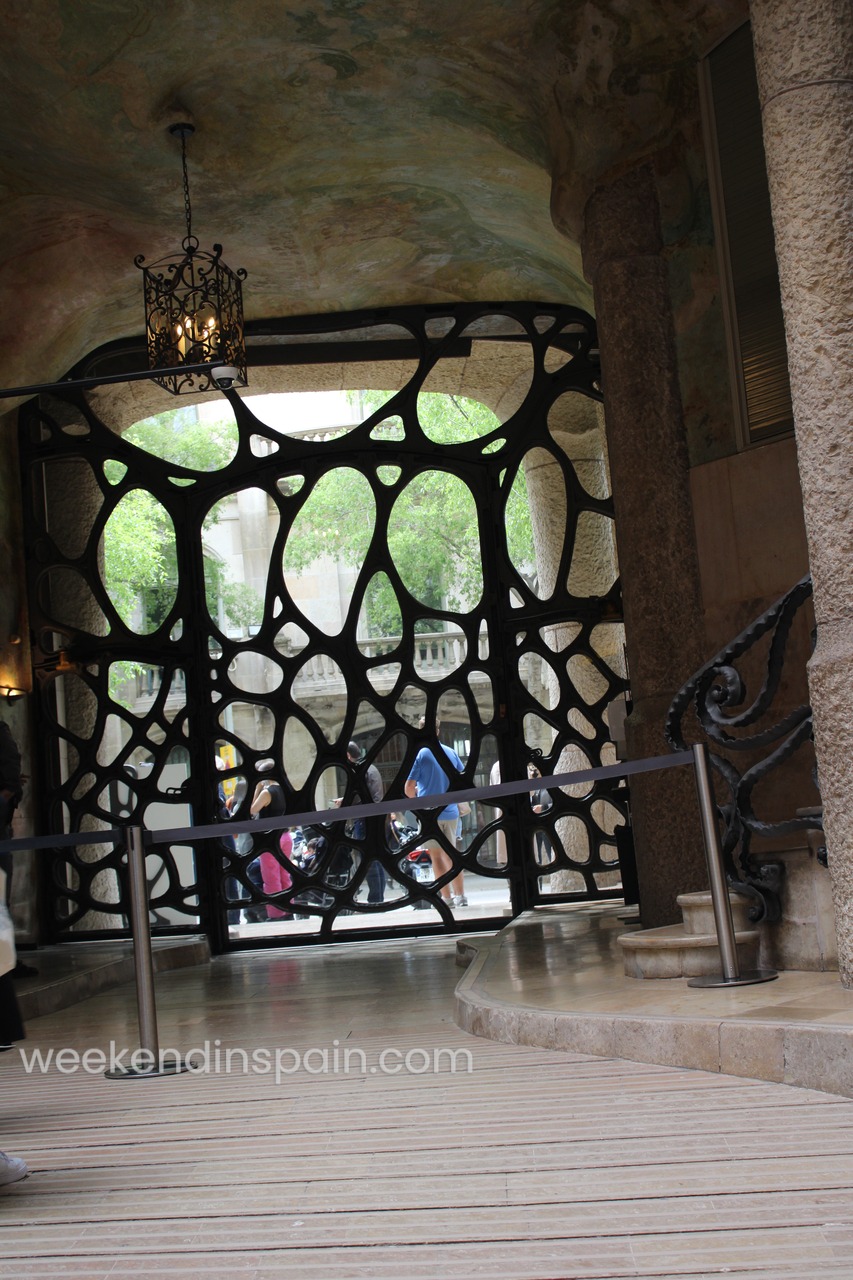
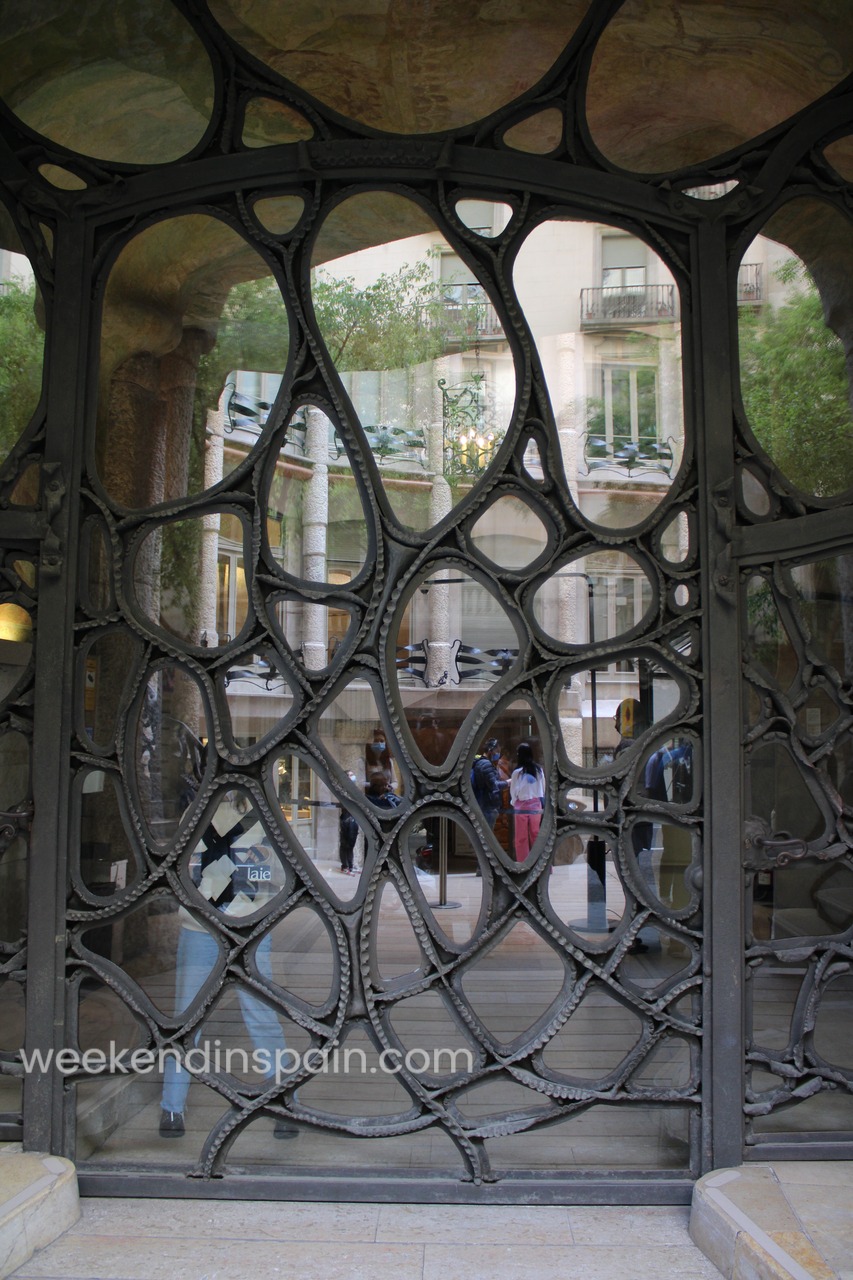
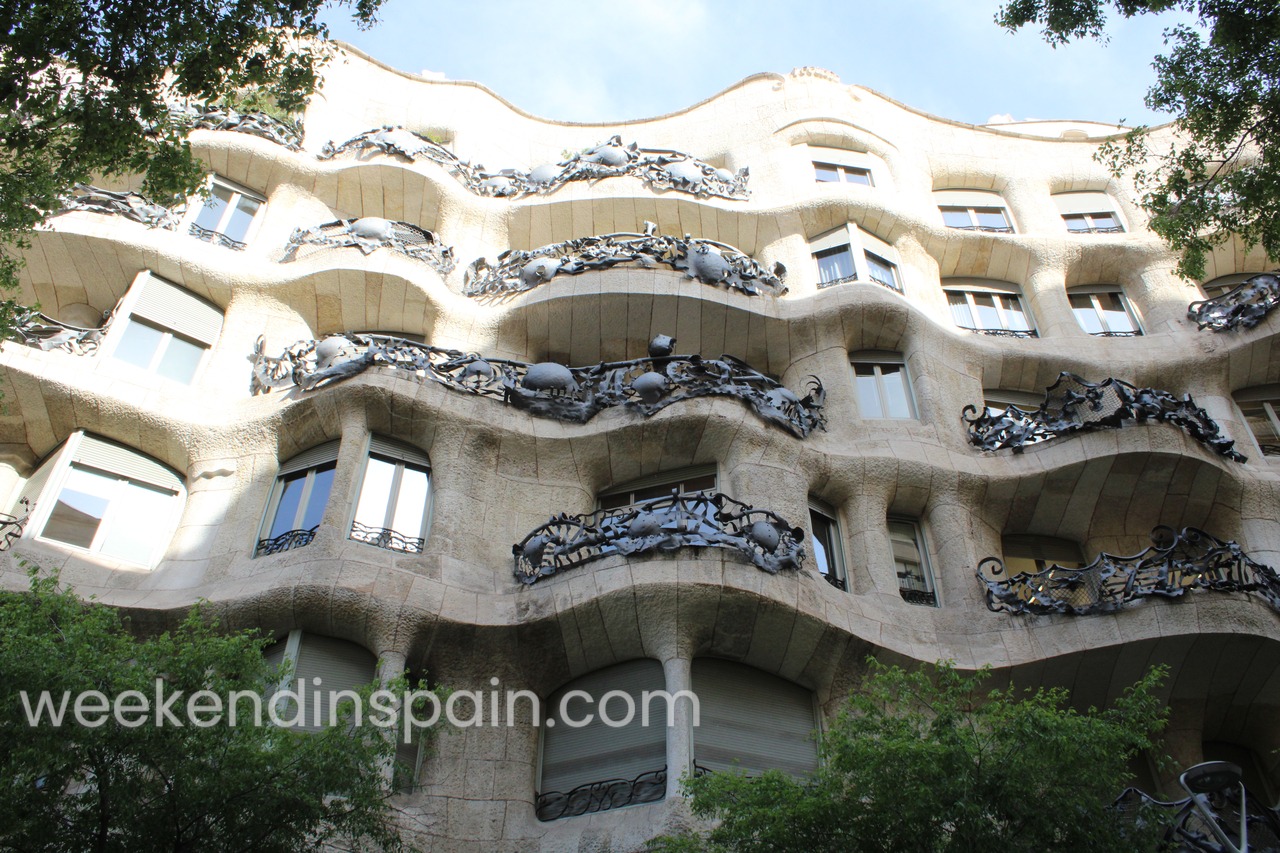
Anyone who sees La Pedrera will at once realise that the building is in the form of sea waves. What especially captures one’s direct attention is the wrought-iron work on the balconies and the entrance gates. The wrought-iron grills that are made out of scrap materials take various forms of nature, especially that of sea life, and they go quite well with the façade, which is made of three different types of limestone—architectural design and creativity at their best.
Even the entrance gates are made of wrought iron. Again, taking the form of nature, like butterfly wings.
THE COURTYARDS
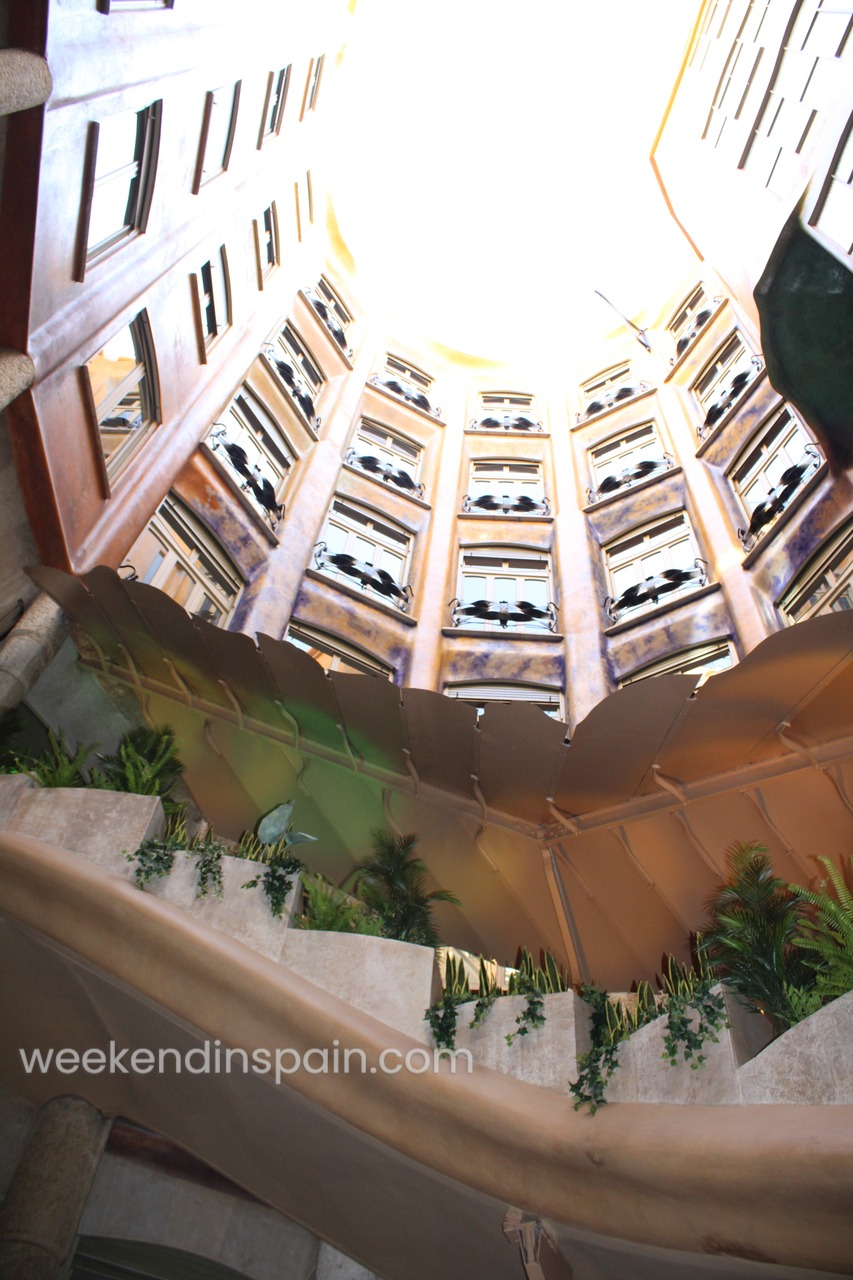
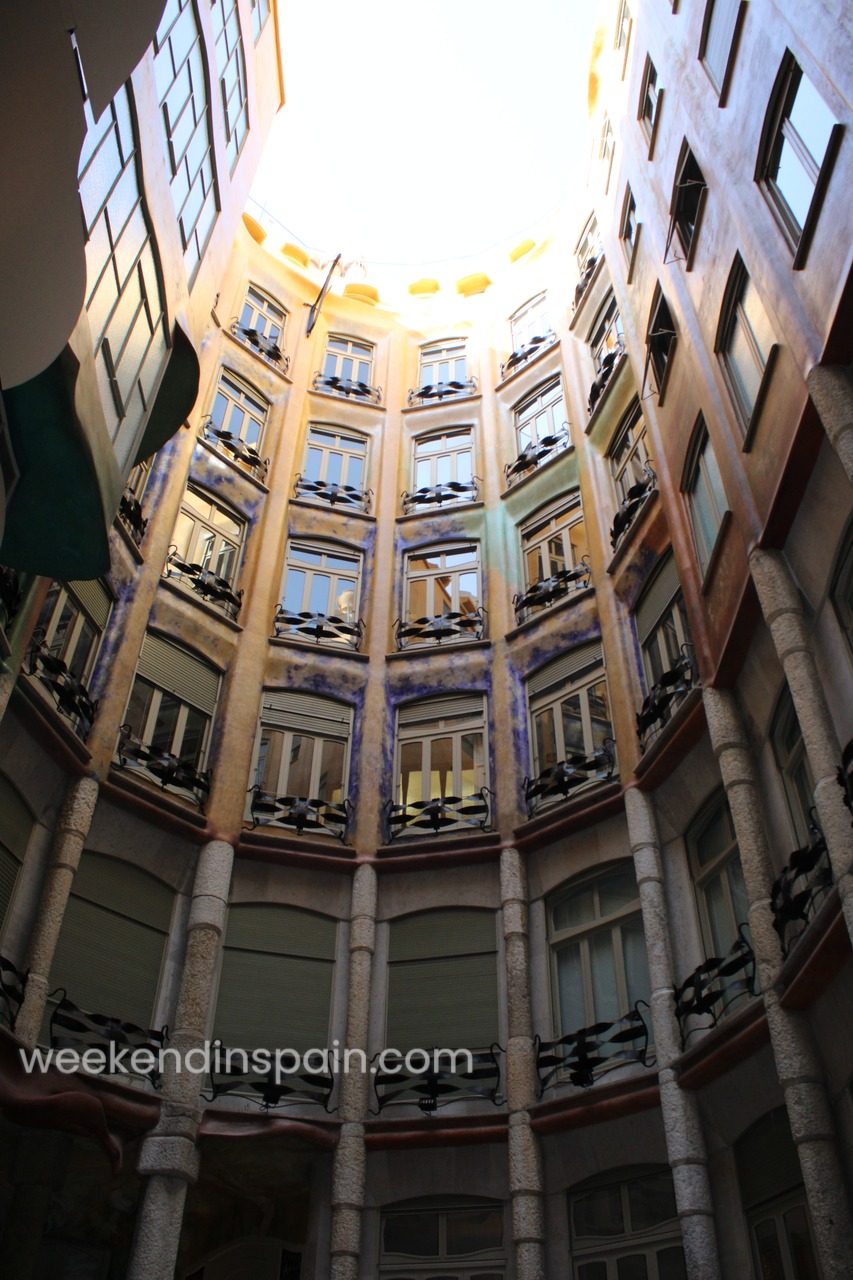
There are two courtyards at La Pedrera, the one at the Carrer Provença entrance is called the Butterfly, while the one at the Passeig de Gràcia entrance is called the Flower Courtyard. The courtyards look as beautiful as the façade of La Pedrera. Once you’re in the courtyards, you can see that the murals on the walls bear a colourful display of floral motifs. All of the art is inspired by mythology.
The walls of the courtyards have huge windows that provide natural light and ventilation into the apartments, which add extra beauty to the circular courtyards.
THE ROOF, THE CHIMNEYS, AND THE VENTILATION TOWERS
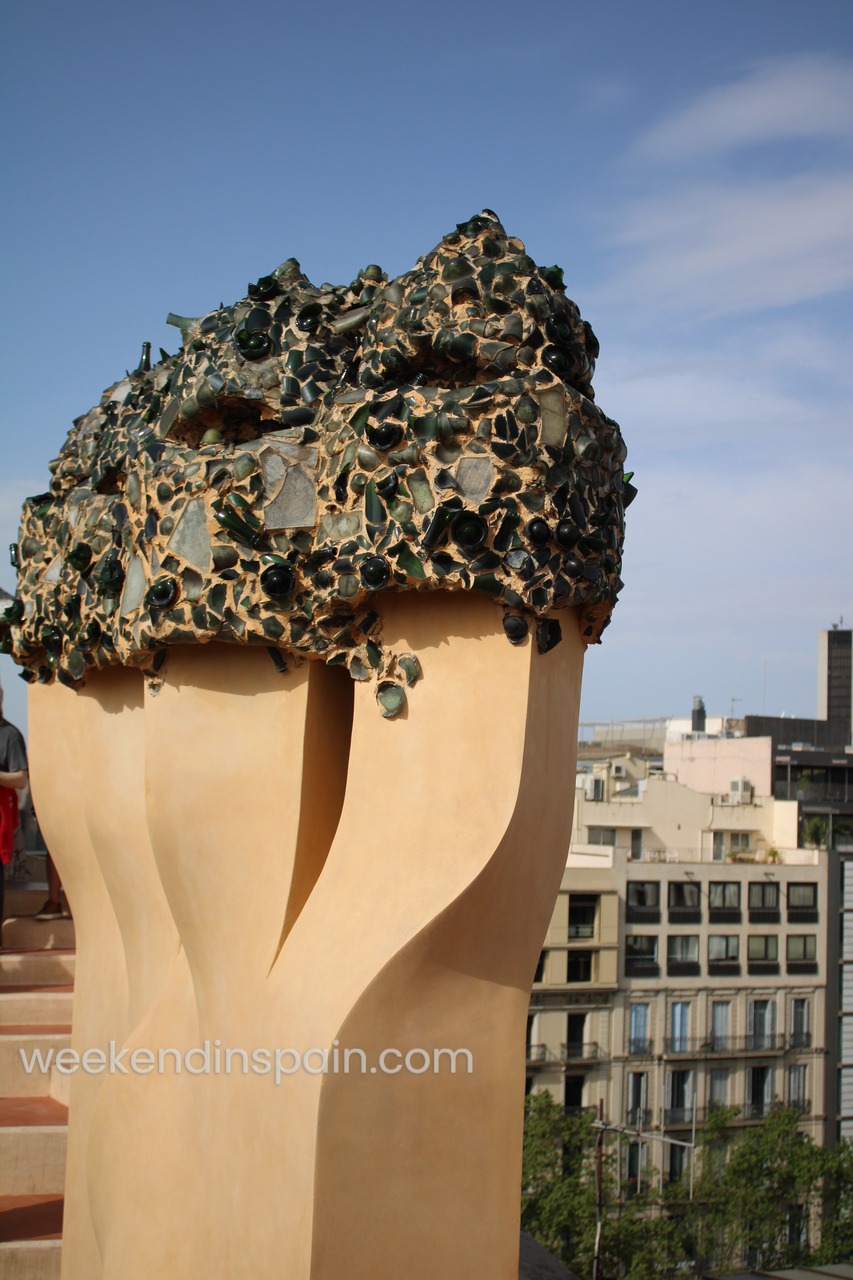
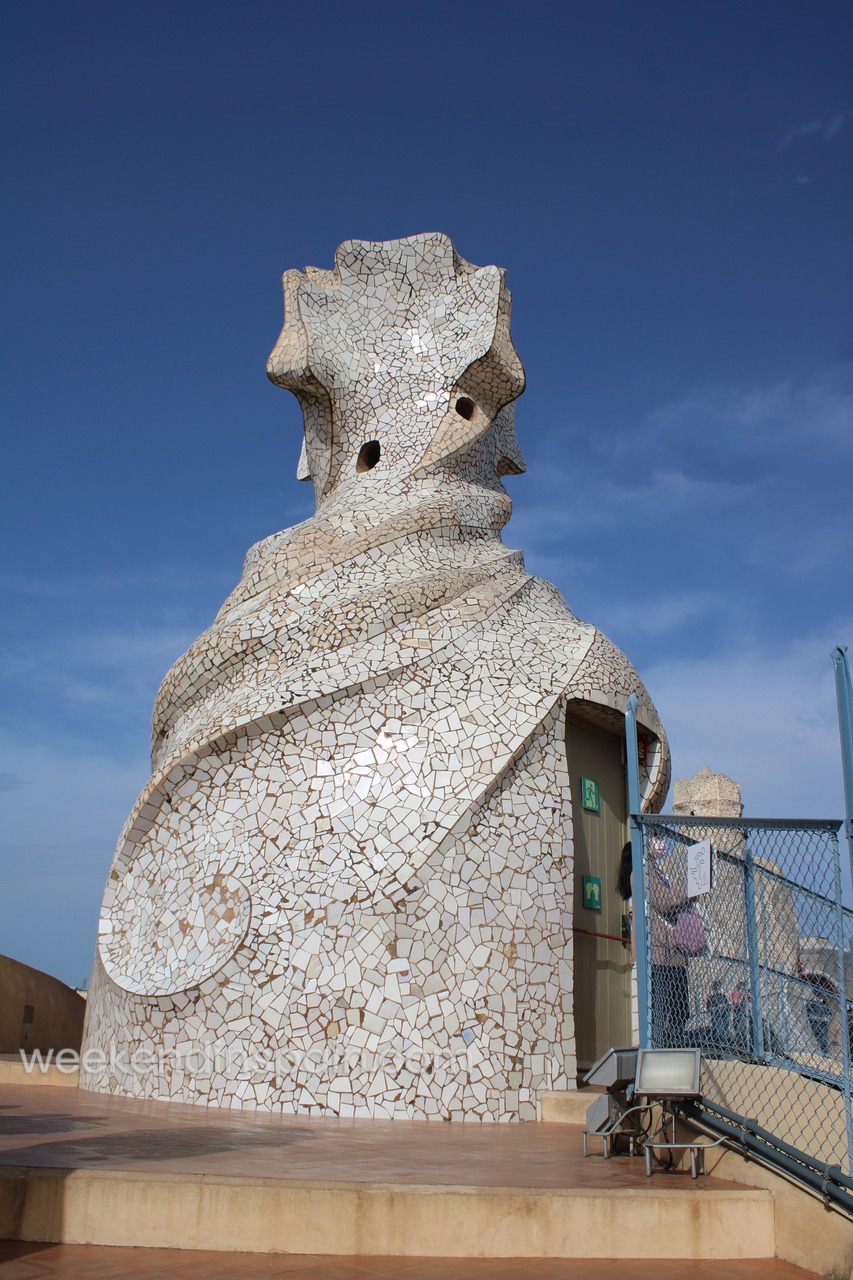
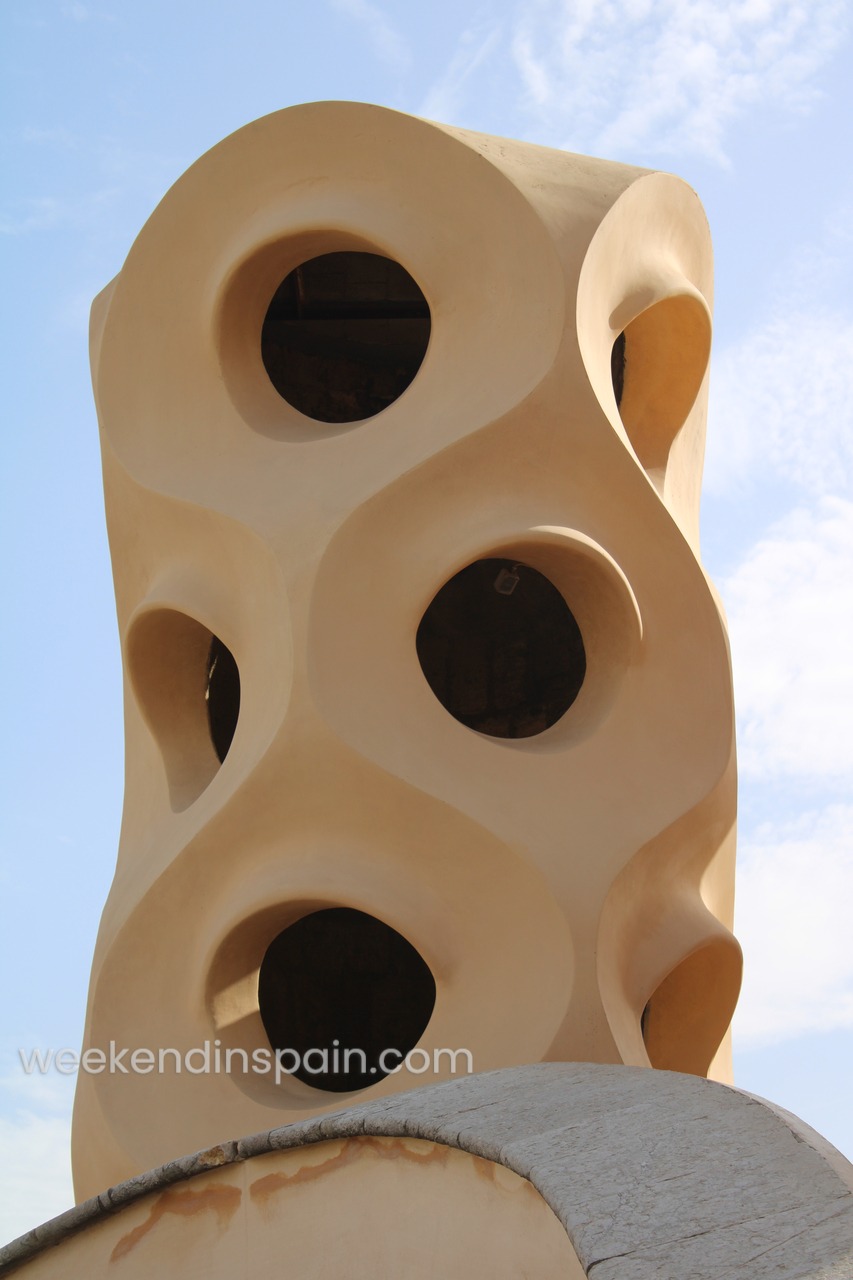
Without a doubt, the undulating and infamous roof terrace of Casa Milá is known for being the most beautiful terrace in the entire city of Barcelona. From the sculptured chimneys to the air vents that Gaudí designed, to the unevenly shaped terrace itself.
Gaudí was not only inspired by nature and faith, but he was fond of recycling. I was surprised to learn that he used waste ceramic, broken glass, and stone to decorate the chimneys and air vents. By looking at the sculptured chimneys and towers, you can clearly tell that Gaud’s priority was ventilation and lighting.
Speaking of the chimneys, my first impression upon seeing them was that the single-designed ones looked like an ice-cream cone with chocolate chip toppings, but that’s just my opinion. However, to some, they also look like trees.
THE ATTIC
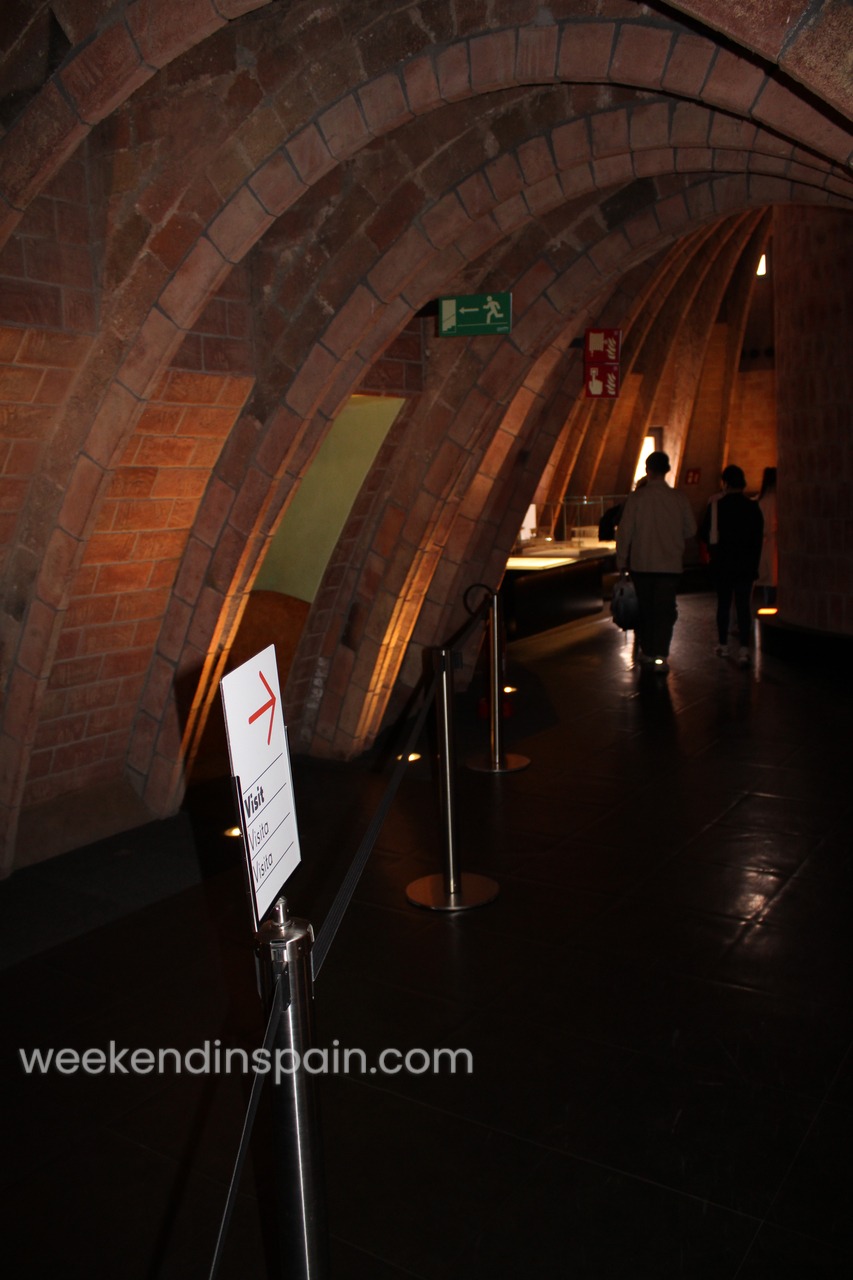
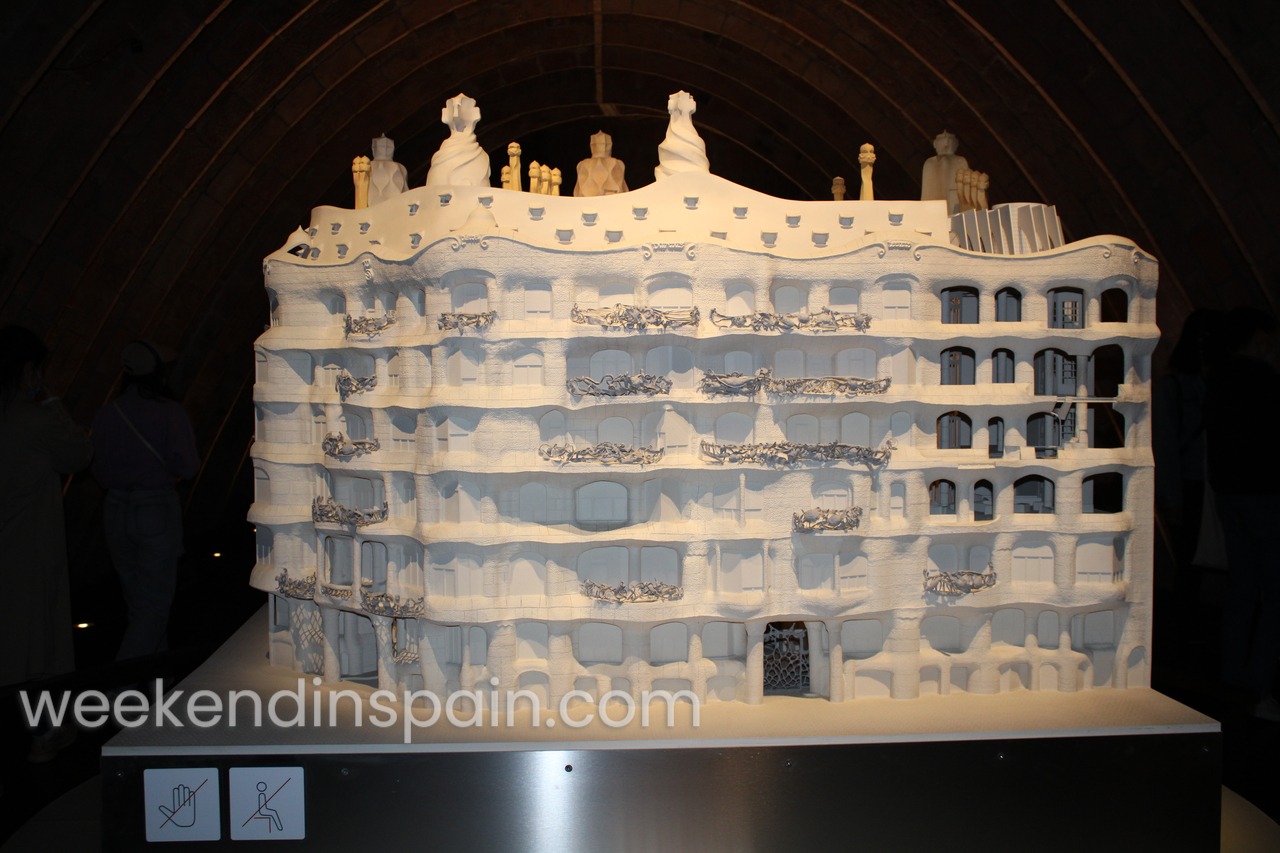
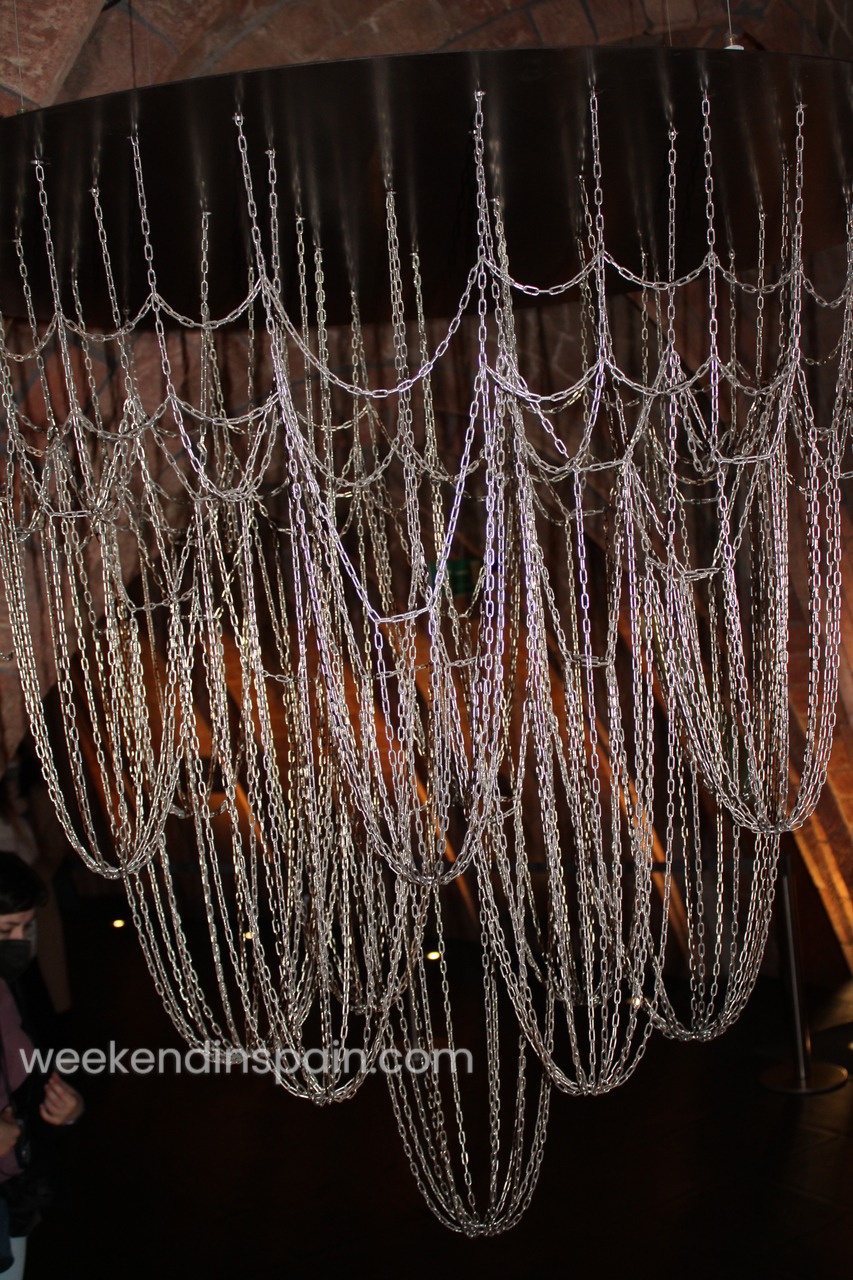
You’ll feel like you’re inside a whale’s ribcage once you’re in the attic. In fact, La Pedrera itself has said it does. Apparently, which is why they have named it “The Whale Attic.”
Inside the attic, you’ll see 270 catenary arches that support the weight of the terrace above. The Attic was actually a communal laundry area, now it is a Gaudí museum, displaying his life and creativity. Among various exhibition items and models, especially all of his creative plans and designs related to La Pedrera. One of which is a miniature model of La Pedrera as you can see in the photo, and also a hanging chain. Speaking of the hanging chain, you’ll also see it at Casa Batlló. My next article is going to be on Casa Battló.
THE APARTMENT
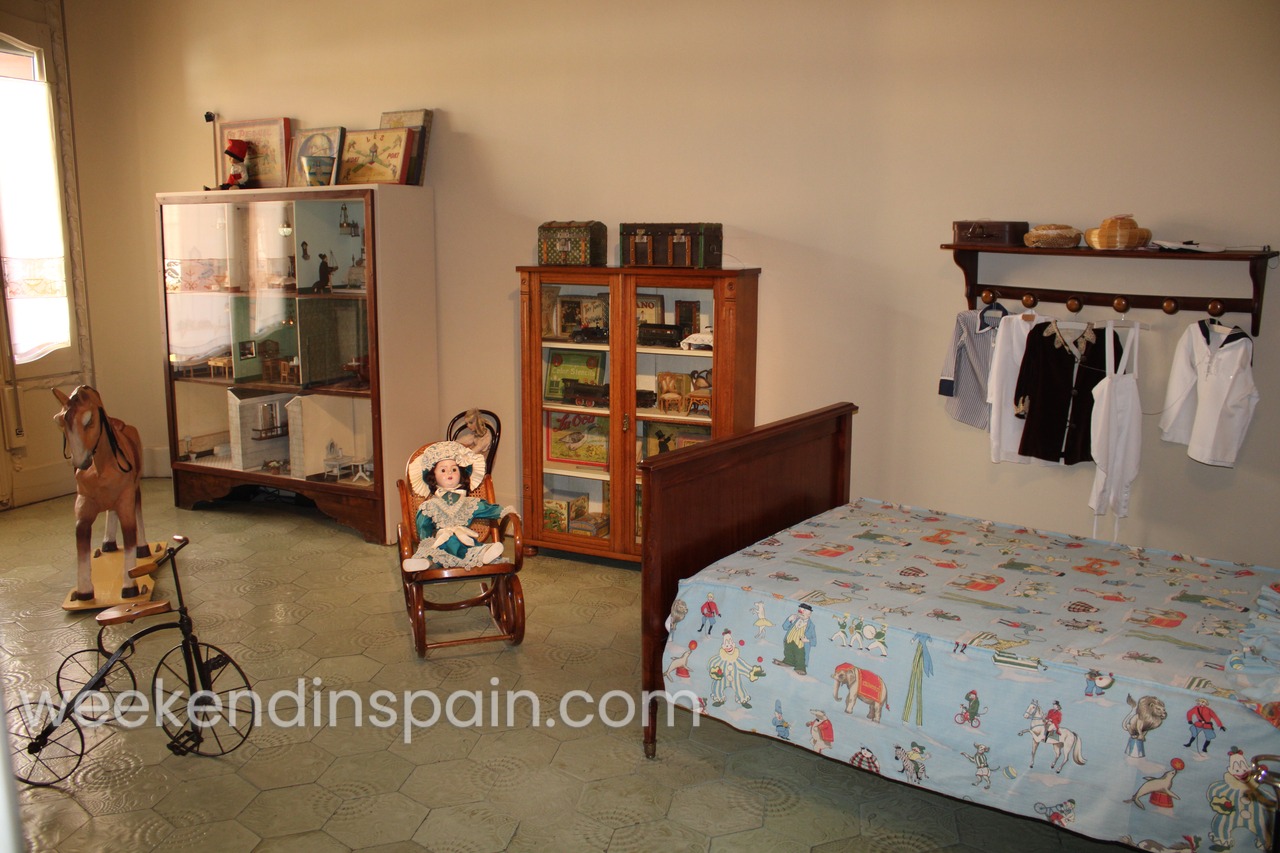
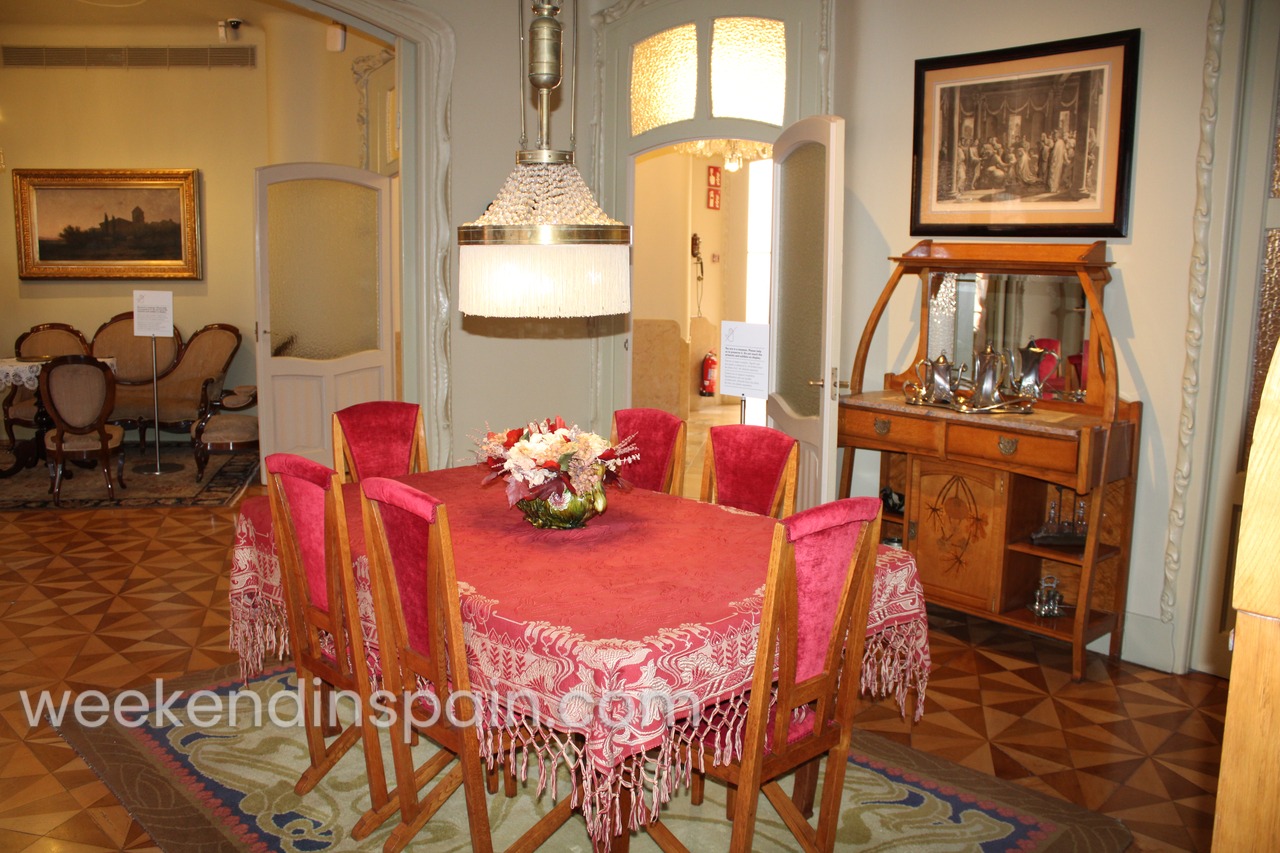
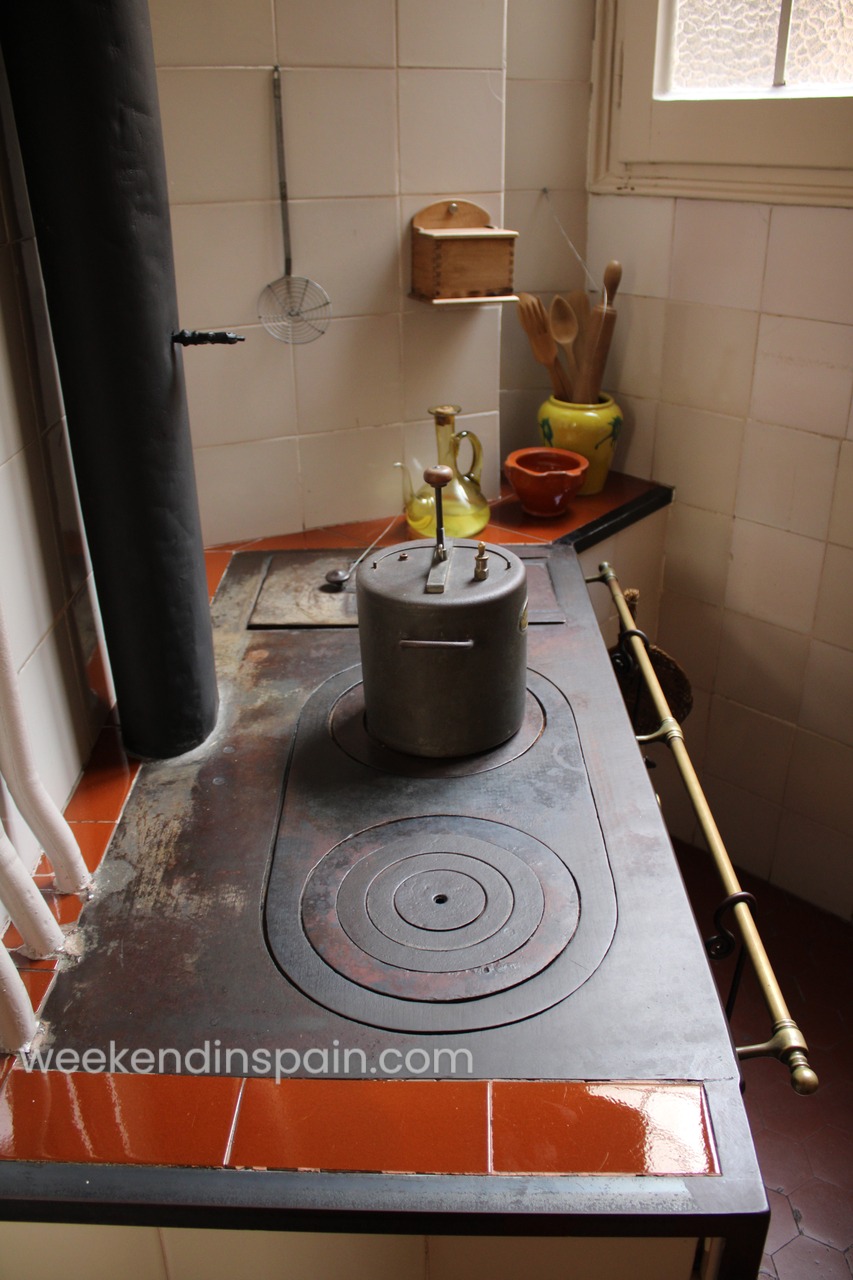
Moving on from the attic, you’ll come across the apartment, which is on the fourth floor. The apartment will give you an idea of the bourgeois family’s lifestyle, including domestic furniture, kitchen utensils, and other household items from the early 20th century. Apart from the furnishings, you’ll also see Gaudí’s impressive interior design, such as, doors, doorknobs, handles, etc.
VIEWS FROM THE ROOFTOP OF LA PEDRERA
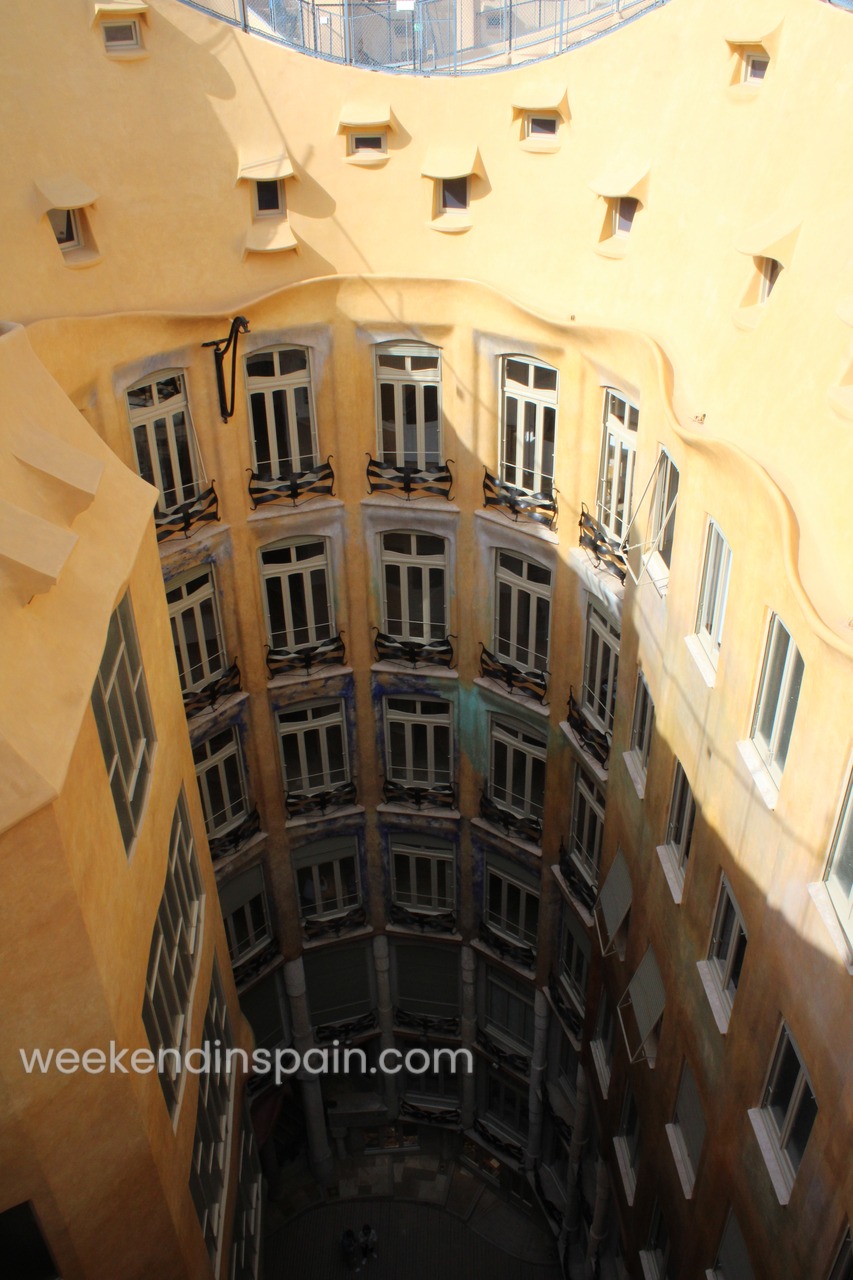
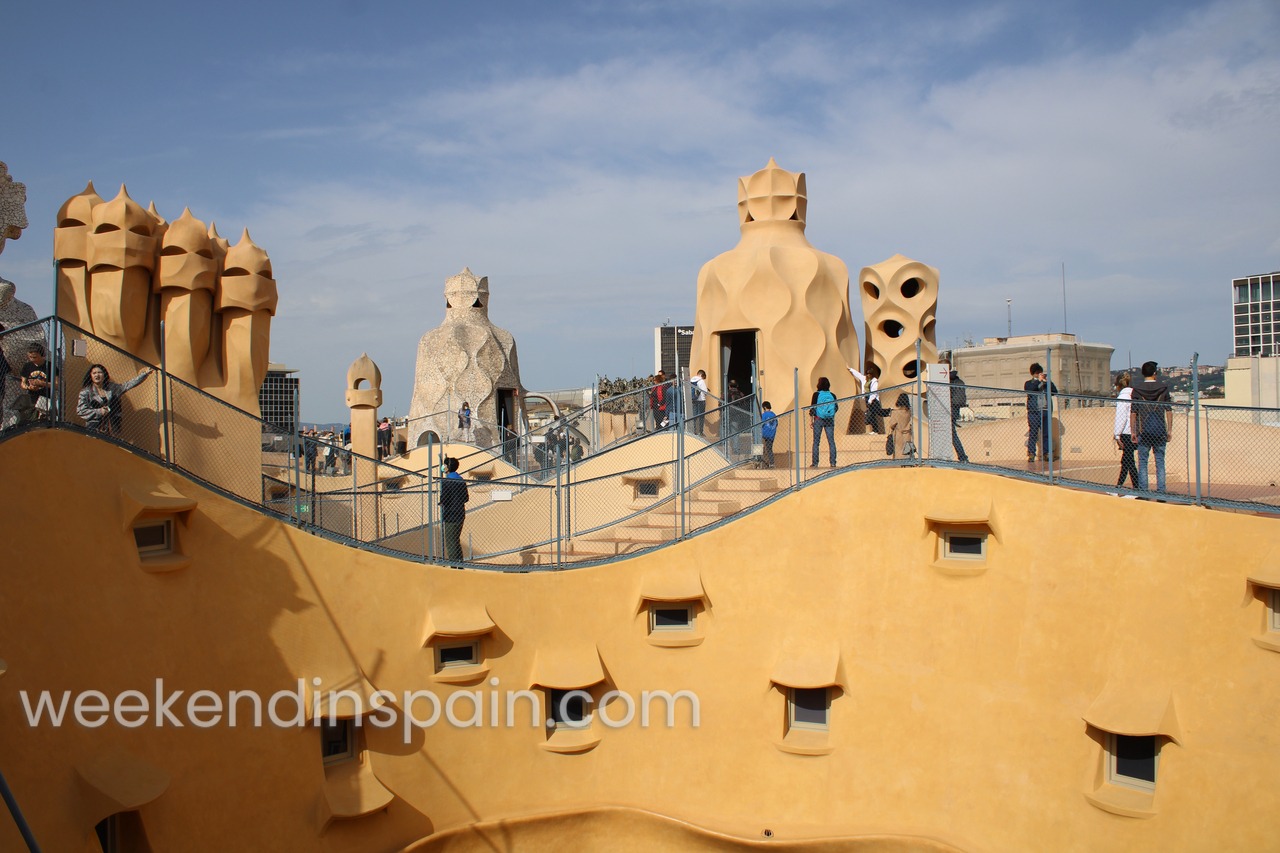
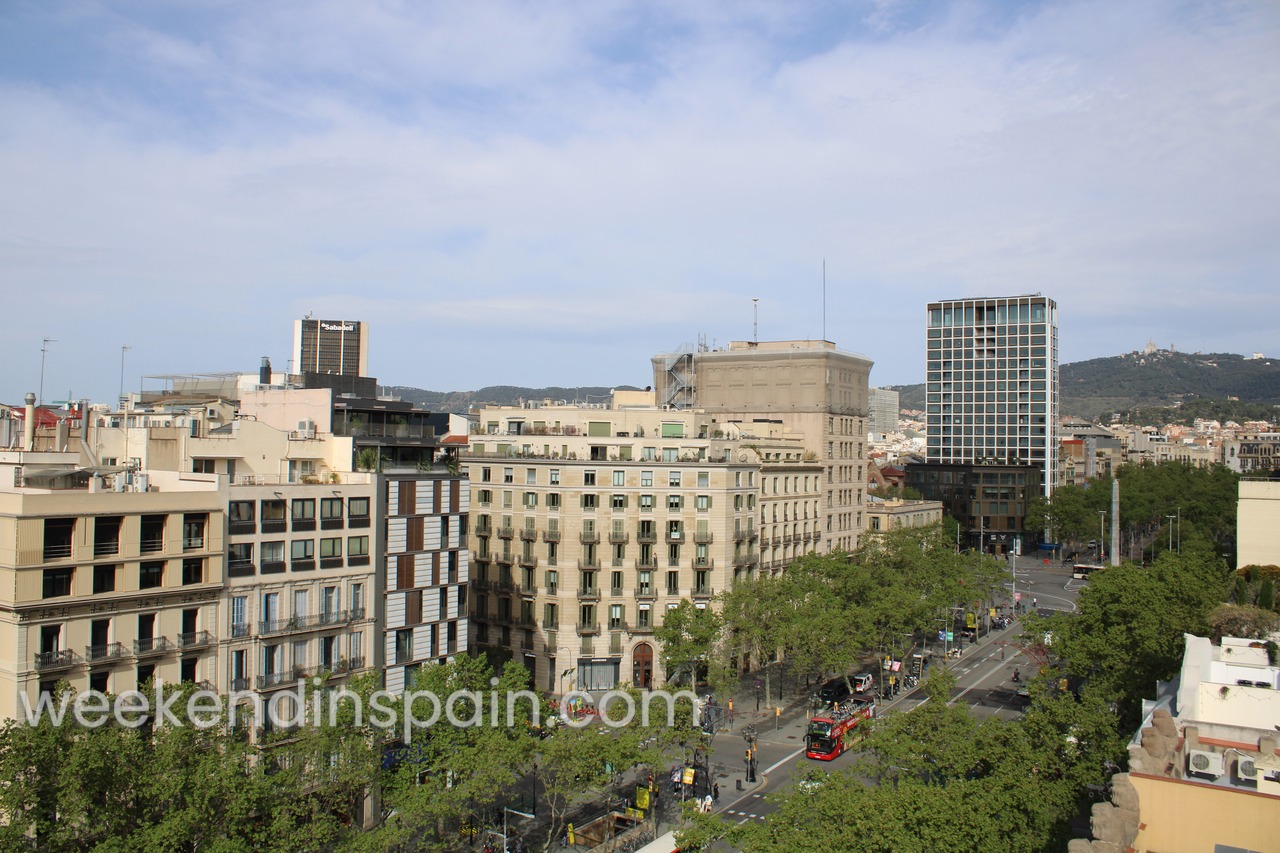
Besides the beautifully designed roof, the views from the top are magnificent, and you can also see other iconic landmarks, such as La Sagrada Familia, Tibidabo, and La Torre Glòries, along with other tall and famous monuments. In the middle of the terrace is the open ceiling, from where you can see the circular walls, patios, and even the courtyards. I tried not to get too close to the edge as I’m afraid of heights, but still managed to grab a pic even though it was well protected.
HOW MUCH TIME DOES IT TAKE TO SEE LA CASA PEDREDA?
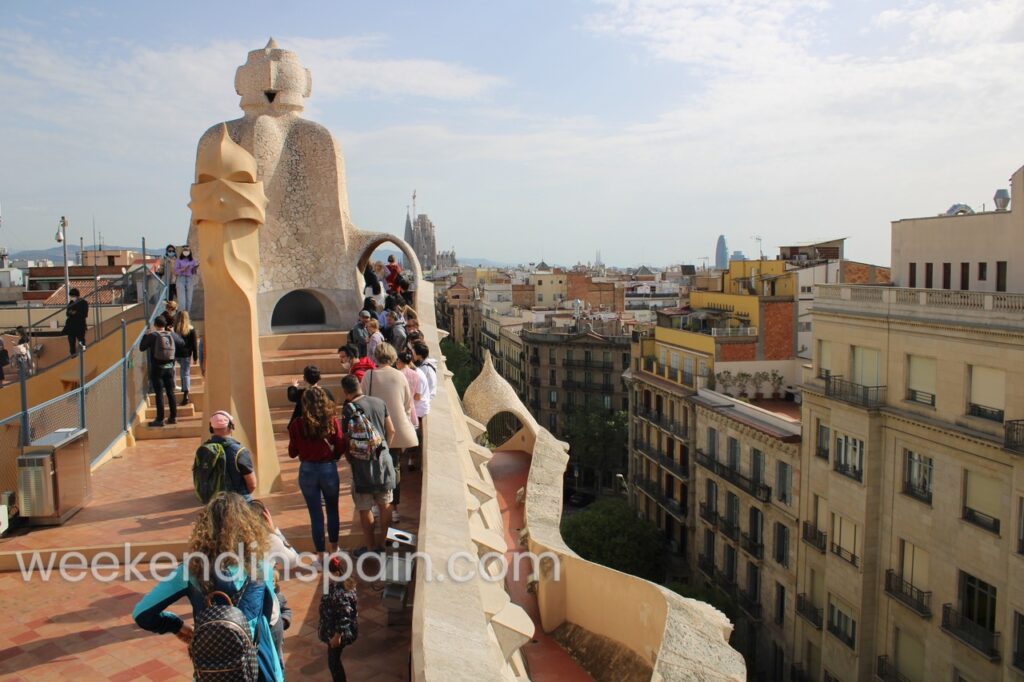
You shouldn’t take more than an hour and 15 minutes max. The most time that you’ll be spending is up on the roof terrace, as there’s so much to see up there, but bear in mind that the most beautiful spots for taking photos are in high demand, as you’ll see from this pic, but if you’re not very fond of taking pictures, you could see the roof terrace in less than 30 minutes.
HOW TO GET THERE
Casa Pedrera is located at Passeig de Gràcia, 92—it’s quite easy to get to from any part of the city.
It depends on where you’re at. You can take either of the following means of transport:
Bus
H10, 7, 34, V15, 33, 34. I’m sure there are many others that take you there.
Metro
L2 (purple line), L3 (green line) and L5 (blue line). Best to take the green line and get off at Diagonal, but if you take the other two lines, you’d still be good.
FGC
Get off at La Provença station.
What we did was that we first went to La Sagrada Familia early in the morning, finished seeing the basilica in less than an hour and a half, and then walked to La Pedrera. It took us less than 15 minutes to get to La Pedrera.
OPENING HOURS
From Monday to Friday: 9:00 a.m.-6:00 p.m.
Weekends and holidays: 10:00 a.m.-2:00 p.m.
- TELEPHONE NUMBER: +34 93 214 25 76
- Email address: [email protected]
In any case, here’s a link to La Pedrera’s website, with the visiting hours and a contact number. It’s a direct link to the precise information, so you do not have to browse through the site looking for it.
https://www.lapedrera.com/en/plan-your-visit/contact-la-pedrera
LA PEDRERA TICKETS
Here’s a link to La Pedrera’s official website, where you can purchase your tickets:
Rates and discounts | Casa Mila, Gaudi’s building in Barcelona (lapedrera.com)
If you’re staying right in the middle of the city centre, you might as well check out La Pedrera and Casa Battló before visiting La Sagrada Familia. Also, both, La Pedrera, and Casa Battló are close to each other, so it’s easy to cover both monuments in less than, I would say, three hours, or at most four hours. It all depends on how busy each place is, too.
BEST TIPS FOR LA PEDRERA – BARCELONA
I hope my article helps you plan your visit to La Pedrera and that you make the most of your trip to Barcelona. You can basically cover La Sagrada Familia, La Pedrera, and Casa Battló as well. I would not recommend checking out Park Guéll on the same day. You can if you want to, but the park is huge and it takes a lot of time to see it, I would say a minimum of two and a half hours. If you do go to Park Guëll, make sure you take something to eat and water along with you, as you’re hiking up and down. Apart from the three beautiful monuments, you might also be able to check out parts of the city centre.
Stay tuned for my next two articles, which are going to be on Casa Battló and Park Güell.
Thanks for stopping by.
